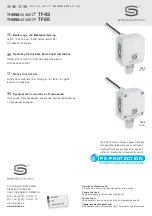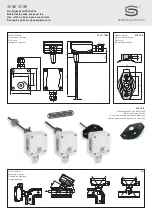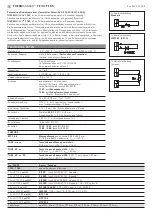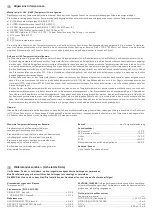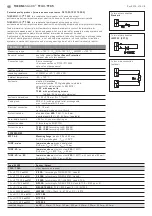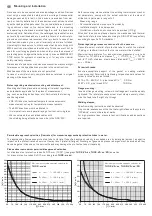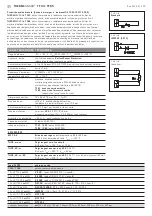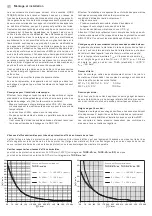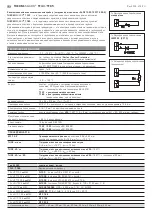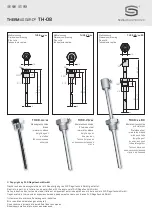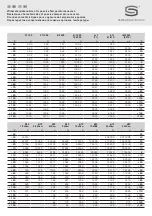
Devices are to be connected under dead-voltage condition. Devices
must only be connected to safety extra-low voltage. Consequential
damages caused by a fault in this device are excluded from war-
ranty or liability. Installation of these devices must only be realized
by authorized qualified personnel. The technical data and connect-
ing conditions shown on the device labels and in the mounting
and operating instructions delivered together with the device are
exclusively valid. Deviations from the catalogue representation are
not explicitly mentioned and are possible in terms of technical pro-
gress and continuous improvement of our products. In case of any
modifications made by the user, all warranty claims are forfeited.
Operating this device close to other devices that do not comply with
EMC directives may influence functionality. This device must not be
used for monitoring applications, which solely serve the purpose of
protecting persons against hazards or injury, or as an EMERGENCY
STOP switch for systems or machinery, or for any other similar
safety-relevant purposes.
Dimensions of enclosures or enclosure accessories may show slight
tolerances on the specifications provided in these instructions.
Modifications of these records are not permitted.
In case of a complaint, only complete devices returned in original
packing will be accepted.
Notes regarding mechanical mounting and attachment:
Mounting shall take place while observing all relevant regulations
and standards applicable for the place of measurement
(e.g. such as welding instructions, etc.). Particularly the following
shall be regarded:
– VDE ⁄ VDI directive technical temperature measurements,
measurement set - up for temperature measurements.
– The EMC directives must be adhered to.
– It is imperative to avoid parallel laying of current-carrying lines.
– We recommend to use shielded cables with
the shielding being attached at one side to the DDC ⁄ PLC.
Before mounting, make sure that the existing thermometer‘s techni-
cal parameters comply with the actual conditions at the place of
utilization, in particular in respect of:
– Measuring range
– Permissible maximum pressure, flow velocity
– Installation length, tube dimensions
– Oscillations, vibrations, shocks are to be avoided (< 0.5 g)
Attention! In any case, please observe the mechanical and thermal
load limits of protective tubes according to DIN 43763 respectively
according to specific S+S standards!
Notes regarding process connection of built-in sensors:
If possible, select material of protective tube to match the material
of piping or tank wall, in which the thermometer will be installed!
Maximum temperatures T
max
and maximum pressures p
max
are as
follows: for TH - MS brass sleeves T
max
= +150 °C, p
max
= 10 bar
and for TH - VA stainless steel sleeves (standard) T
max
= +400 °C,
p
max
= 40 bar.
Screw-in threads:
Ensure appropriate support of the gasket or sealing material
when mounting! Permissible tightening torque standard values for
screw - in threads, are as follows:
M 18 x 1.5; M 20 x 1.5; pipe thread G ½ " : 50 Nm
M 27 x 2.0; pipe thread G ¾ "
: 100 Nm
Flange mounting:
In case of flange mounting, screws in the flange part must be equally
tightened. The lateral pressure screw must clamp securely, other-
wise the feeler shaft might slip through.
Welding sleeves:
Specific welding instructions shall be observed.
On principle, unevenness or the like that might influence the system‘s
”CIP ability“ must not develop at welds.
For high-pressure lines, pressure test certifications and inspections
are required.
G
Mounting and Installation
50
75
100 125 150 175 200 225 250 275 300 325 350 375 400
0
10
15
5
20
25
30
35
40
50
75
100 125 150 175 200 225 250 275 300 325 350 375 400
0
8
10
12
14
4
6
16
20
18
22
24
26
28
30
2
P = 1 bar ⁄ T = 100 - 200 °C (steam)
P = 20 bar ⁄ T = 100 °C (water)
P = 20 bar ⁄ T = 200 °C (water)
P = 1 bar ⁄ T = 100 - 200 °C (steam)
P = 20 bar ⁄ T = 100 °C (water)
P = 20 bar ⁄ T = 200 °C (water)
[v
]
=
m
⁄ s
[v
]
=
m
⁄ s
[l] = mm
[l] = mm
Maximum permissible approach velocities for
TH 08 - ms ⁄ xx
Maximum permissible approach velocities for
TH 08 - VA ⁄ xx, TH 08 - VA ⁄ xx ⁄ 90
Permissible approach velocities (flow rates) for crosswise approached protective tubes in water.
The approaching flow causes protective tube to vibrate. If specified approach velocity is exceeded even by a marginal amount, a negative
impact on the protective tube's service life may result (material fatigue). Discharge of gases and pressure surges must be avoided as they
have a negative influence on the service life and may damage the protective tubes irreparably.
Please observe maximum permissible approach velocities
for stainless steel protective tubes 8 x 0.75 mm (1.4571) (see graph TH 08 - VA ⁄ xx, TH 08 - VA ⁄ xx ⁄ 90) as well as
for brass protective tubes 8 x 0.75 mm (see graph TH 08 - ms ⁄ xx) :

